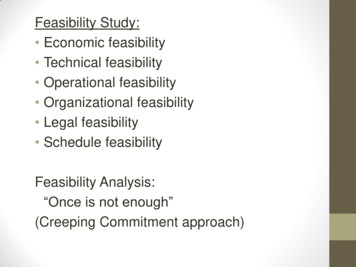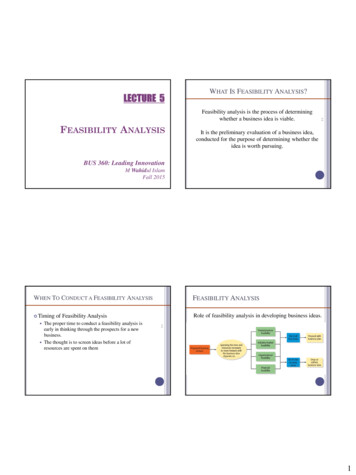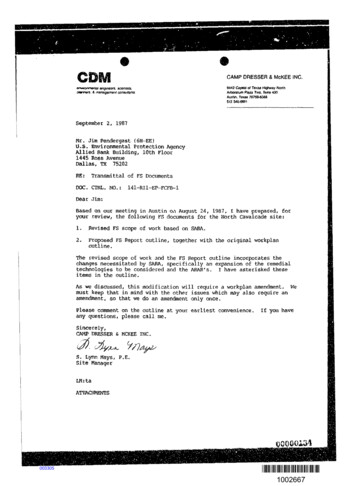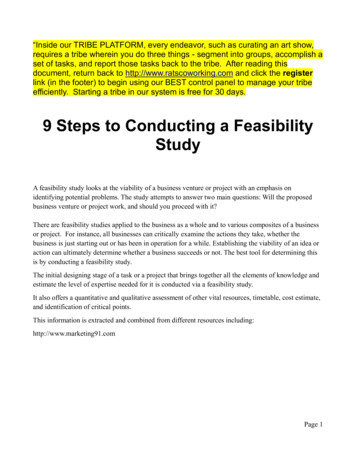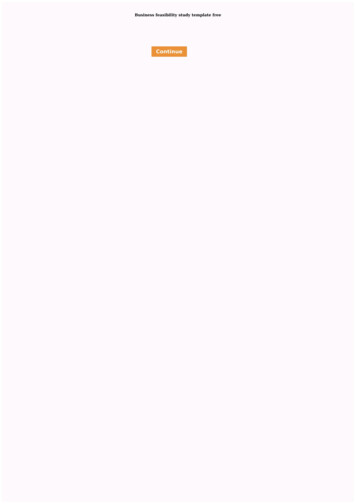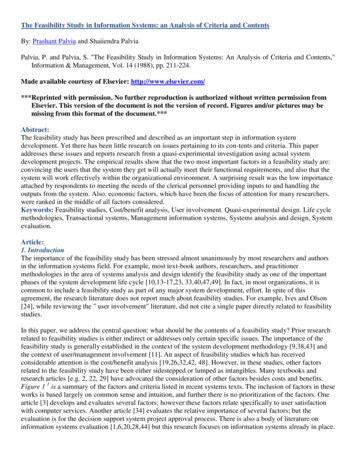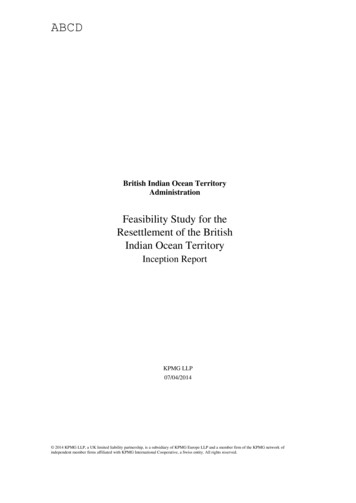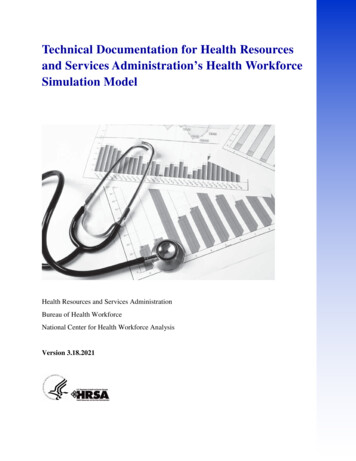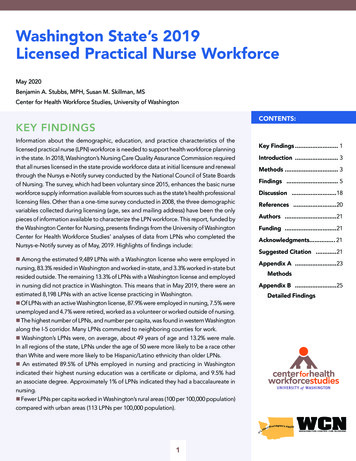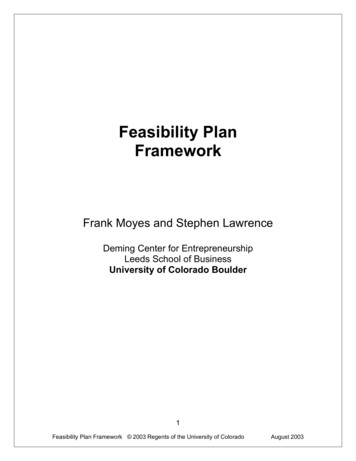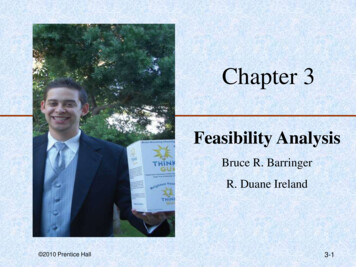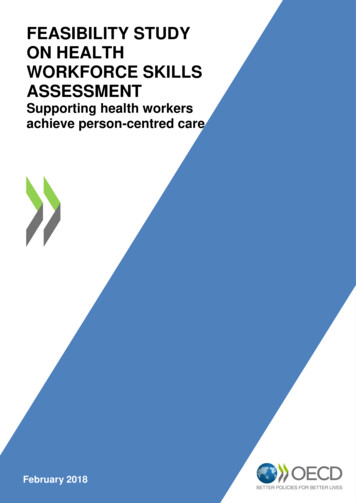
Transcription
FEASIBILITY STUDYON HEALTHWORKFORCE SKILLSASSESSMENTSupporting health workersachieve person-centred careFebruary 2018
Feasibility Study on HealthWorkforce SkillsAssessmentSupporting health workers achieve personcentred care
Feasibility Study on HealthWorkforce SkillsAssessmentSupporting health workers achieve personcentred careREFERENCE:Grant D00004 n 2015 53 02.Authors: OECD Health Division teamThis document and any map included herein are without prejudice to the status of or sovereignty over anyterritory, to the delimitation of international frontiers and boundaries and to the name of any territory, cityor area.This document has been produced with the financial assistance of the European Union. The opinionsexpressed and arguments employed herein do not necessarily reflect the official views of the OECD membercountries or of the European Union.Health Divisionwww.oecd.org/healthDirectorate for Employment, Labour and Social Affairs
AcknowledgementsThe authors would like to thank the members of the Expert Working Group andparticipants in the Stakeholder Consultative meeting and interviews who contributedtheir valuable time and effort in providing feedback and insightful suggestions to thisreport. Their names are too long to list here, and are shown in Annex 1, 2 and 3 ofthe report. We would also like to acknowledge the contributions Alex Berland whoprovided inputs on the scenarios and cases to illustrate the topics and questions to beincluded in the skills survey. Our thanks also go to William Thorn and FrancescaBorgonovi from OECD Education Division for their advice and guidance on theProgramme for International Assessment of Adult Competencies (PIAAC), andcolleagues from OECD Health Division who provided advice on various healthsector survey instruments.Feasibility Study on Health Workforce Skills Assessment @ OECD 20183
Abbreviations and ssociation of Canadian Faculties of DentistryFramework developed by the Royal College of Physicians andSurgeons of Canada that identifies and describes the abilitiesphysicians require to effectively meet the health care needs of thepeople they serveEuropean Centre for the Development of Vocational TrainingCommunity Health WorkerCommittee of Postgraduate Dental Deans and Directors UKContinuous Professional DevelopmentStanding Committee of European DoctorsEuropean Federation of Nurses AssociationsEuropean Specialist Nurses OrganisationsInternational Pharmaceutical FederationGeneral PractitionerInternational Council of NursesInformation and Communication TechnologyInternational Labour OrganisationNational Academy of Medicine (USA)OECD Programme for International Assessment of AdultCompetenciesPharmaceutical Group of the European UnionNurse Forecasting in Europe Research ProgrammeOECD Teaching and Learning International SurveyEuropean Union of Medical SpecialistsWorld Federation of Medical EducationWorld Health OrganizationFeasibility Study on Health Workforce Skills Assessment @ OECD 20184
GlossaryAdaptive problem solvingAdaptive problem solving refers to an individuals’ capacity toflexibly and dynamically adapt their problem solving strategies tothe environment in which they operate, identify and select amonga range of available resources, highlighting the centrality of areflexive, flexible, and adaptive mind. Adaptive problem solvingtakes place at the interface between the internal, mental world ofthe problem solver and the external world that makes informationavailable in the physical, social, and digital environment that canbe used as problem solving resources.Health AssociateProfessionals(ISCO-8 Group 32, excluding veterinarians) perform technicaland practical tasks to support diagnosis and treatment of illness,disease, injuries and impairments in humans and animals, and tosupport implementation of health care, treatment and referralplans usually established by medical, veterinary, nursing andother health professionals. Tasks performed by workers in thesub-major group usually include: testing and operating medicalimaging equipment and administering radiation therapy;performing clinical tests on specimens of bodily fluids andtissues; preparing medications and other pharmaceuticalcompounds under the guidance of pharmacists; designing, fitting,servicing and repairing medical and dental devices andappliances; providing nursing and personal care and midwiferysupport services; using herbal and other therapies based ontheories, beliefs and experiences originating in specific cultures.Health ProfessionalsThis category of workers (ISCO-8 Group 22, excludingveterinarians) conduct research; improve or develop concepts,theories and operational methods; and apply scientific knowledgerelating to medicine, nursing, dentistry, pharmacy, and promotionof health. Competent performance in most occupations in thissub-major group requires skills at the fourth ISCO skill level.Patient-centred careProvision of care that is “respectful of and responsive toindividual patient preferences, needs, and values and ensuring thatpatient values guide all clinical decisions." (IOM 2001)Feasibility Study on Health Workforce Skills Assessment @ OECD 20185
People-centred carePeople-centred health services are an approach to care thatconsciously adopts the perspectives of individuals, families andcommunities, and treats them as participants as well asbeneficiaries of trusted health systems that respond to their needsand preferences in humane and holistic ways. People-centred carerequires that people have the education and support they need tomake decisions and participate in their own care, and is organizedaround the health needs and expectations of people rather thandiseases. It extends beyond person-centred care in that it includespublic health and population-based programmes.See WHO plecentred-care/ipchs-what/en/Person-centred carePerson-centred care is an approach to healthcare that offerspersonalised care customised to the particular health and socialneeds of the individual, and views the persons using health andsocial services as equal partners in planning, developing andmonitoring care to make sure it meets their needs. This meansputting the person and their families as integral members of thedecision-making process, and seeing them as experts in their ownright, working in partnership with the health professionals, toachieve the best experience and outcome for the individual.SkillsIn most of the literature as well as in policy-relevant work,knowledge, competencies, abilities, and, to a lesser extent, eveneducation are often used interchangeably (OECD). In this report,the term “skill” is used to indicate all types and facets ofcompetences needed by workers to perform their jobs.Distinctions between different dimensions are made only whererelevant. This is done partly for the sake of simplicity but alsobecause of a general lack of agreement on what each of theseterms refers to. Indeed, although there are some conceptualdifferences between them, all terms refer to the interactionsbetween workers and their jobs and relate to the same problematicof shortages and surpluses in the labour market, with similarmethods applied to estimate their imbalances. Skills are generallya combination of ability, capacity and knowledge acquiredthrough deliberate, systematic, and sustained efforts to carry outcomplex tasks or job functions. These can be grouped intocognitive skills (concepts, ideas), technical skills, andinterpersonal skills. Skills can also be classified as job-specificor generic/transversal.Feasibility Study on Health Workforce Skills Assessment @ OECD 20186
Skills MismatchMismatch either refers to the inadequacy of a worker’s skillsrelative to the requirements of the job he/she is currently in (e.g.having a lower level of qualification than generally required forthe job, or being trained in a field of study other than the onegenerally required for the job), or to the opposite phenomenonwhereby a worker’s skills exceed those required by the job (e.g.having a higher level of qualification than generally required forthe job). Mismatch can be measured relative to qualification level,field of study or skills.Transversal SkillsTransversal skills and competences are relevant to a broad rangeof occupations and economic sectors. They are often referred to ascore skills or “soft” skills and are the cornerstone for the personaldevelopment of a person, and are the building blocks for thedevelopment of the other job-specific skills and competencesrequired to succeed on the labour market.Feasibility Study on Health Workforce Skills Assessment @ OECD 20187
Table of contentsAcknowledgements . 3Abbreviations and acronyms . 4Glossary . 5Executive Summary . 101. Introduction . 141.1. Background . 141.2. Objective . 151.3. Methodology . 152. Defining the Skills Challenges . 172.1. Drivers for change in the general labour market. 172.2. Drivers of change in the health sector. 182.3. Evidence of strain on the health workers . 203. Review of competency frameworks and skills surveys. 253.1. Definition of Competency and Skills . 253.2. Whose skills are we measuring? . 263.3. Review of competency frameworks for health professionals . 283.4. Review of Skills Surveys – implications and discussion . 304. Conceptual Framework for Health Sector Skills Assessment . 324.1. Proposal for a Common Competency Framework . 324.2. Identifying shared skills requirements across healthcare systems . 334.3. Understanding the health system and policy context . 365. Defining the skills . 435.1. Transversal skills for personalised healthcare . 435.2. Skills sets for personalised care . 455.3. Skills for non-routine tasks in complex environment . 515.4. Skills supporting positive work culture . 536. How to measure skills – proposed methodology . 566.1. Instruments for assessment of transversal skills and their use at work . 566.2. Self-reporting tools for skills and skills use assessment . 596.3. Direct skills assessment tools. 646.4. Survey sampling and administration . 677. Conclusion and Next Steps . 717.1. Key Findings . 717.3. Next Steps . 73References . 75Feasibility Study on Health Workforce Skills Assessment @ OECD 20188
TablesTable 1 - Examples of skills required in New and Emerging occupations . 18Table 2 - Occupations with the largest numbers of people employed in human health & social workactivities in 2015 in EU . 27Table 3 – Self-reporting questionnaire on teamwork . 58Table 4 – Questionnaire on attitudes toward patient involvement . 61Table 5 – Questionnaire on shared decision making . 62Table 6 – Questionnaire on team fitness . 62Table 7 - How confident are you that you can successfully perform the following tasks? . 63Table 8 - Key competencies and skills covered in the Survey of Adult Skills (PIAAC) . 86Table 9 - Skills Use Indicators . 87FiguresFigure 1 - Index of Changing Work Tasks in the U.S. Economy 1960-2009 . 17Figure 2 - Likelihood of reporting being over-skilled or under-skilled by occupation groups, PIAAC2011-12 . 21Figure 3 - Likelihood of reporting being over-skilled and under-skilled by nurses by levels ofeducation, PIAAC 2011/2012 . 22Figure 4 - Reported skills use by physicians, nurses and other occupations, PIAAC, 2011-12 . 23Figure 5 - Domains of competencies for health professionals, by areas of focus . 33Figure 6 - Assignment of Functions to Different Categories of Health Workers in a Complex CareTeam . 34Figure 7 - Common Features and Functions of an Effective Care Model for High-Need, High-CostPatients . 35Figure 8 - Health system context for skills assessment . 37Figure 9 - Transversal (generic and non-job specific) skills required for successful transition towardsintegrated and personalised models of care . 45Figure 10 - Conceptual framework behind the skills assessment tools: example for developingteamwork assessment . 58Figure 11 - Overview of Health Workforce Skills Assessment Survey Approach . 69BoxesBox 1 – Expanding application of e-health and telehealth . 19Box 2 - Definition of Competency and Skills . 26Box 3 –Identifying priority population groups for Person-centred Care Programme, NHS Sheffield. 40Box 4 – Norwegian Ministry of Health and Care Services guidelines on involving patients inhealthcare. 41Box 5 - Patient’s personal and social context as elements of effective care . 46Box 6 – The importance of shared decision making for personalised care . 48Box 7 – The challenges of variations in cultural norms to health care delivery . 49Box 8 – Interprofessional collaboration between pharmacists and prescribing clinicians . 50Box 9 – Importance of skills in adaptive problem solving for personalised care. 51Box 10 - Complex ethical situations - end of life in hospital setting . 54Box 11 – Example of a patient scenario . 63Box 12 - TALIS International sampling plan . 68Box 13 - Summary of PIAAC Instruments . 85Feasibility Study on Health Workforce Skills Assessment @ OECD 20189
Executive SummaryMany EU member states and other OECD countries are facing significant healthsystem challenges from the increasing demand for healthcare in a fiscally constrainedenvironment. These challenges emerge from many causes: the rising proportion ofageing citizens with multiple chronic conditions and complex social situations, rapiddiffusion of new technologies and increasing complexity of care, and ever morestringent financial constraints. In response, many OECD governments are callingfor major reforms in the health system toward more integrated and personalisedforms of care. Health workers find themselves at the centre of these convergingforces that demand the delivery of high quality care with ever greater flexibility,efficacy and efficiency in an increasingly complex and changing environment.These pressures are placing enormous strains on the health workforce.This isevident, for example, in the increasing rate of “burn-out” (Dyrbye, et al., 2017)among different categories of health professionals, which could negatively affecttheir ability to provide safe and effective care for patients. Burn-out also contributesto attrition, exacerbating human resource shortages. Another manifestation of thestrain on the workforce is the high rates of skills mismatch reported by doctors andnurses in comparison to other professional workers (Schoenstein, Ono, & LaFortune,2016). These findings have raised deep concerns among health policy makers aboutboth the capacity of health workers to meet these demands, and the urgent need toidentify appropriate policy interventions that will enable health workers to meet thesechallenges.ObjectivesThis study reviews the status of existing surveys that measure health professionalskills, and identifies gaps where more attention and resources will be needed togenerate policy-relevant evidence on skills requirements, skills use and skillsmismatch in healthcare settings. Furthermore, the study explores the feasibility ofdeveloping a standardised approach to analyse these gaps and allow internationalcomparability, taking into account the diversity of health care systems, andcomparability across different categories of health professionals.FindingsIncreasingly, health care professionals need to apply adaptive problem-solving skillsto respond to complex and non-routine patient care issues, while working incomplex, multi-disciplinary and frequently stressful occupational environments. Inthe coming years, countries will need resilient and flexible health workers who arearmed not only with technical and clinical skills, but with cognitive, self-awarenessand social skills that will enable them to monitor and assess the situation, makeFeasibility Study on Health Workforce Skills Assessment @ OECD 201810
decisions, take a leadership role, and communicate and co-ordinate their actionswithin a team in order to achieve high levels of patient safety and efficiency, as wellas to assure their own safety and job satisfaction.Segmentation of health professional skills assessment. A large set of skillsassessment instruments exists to measure specialised and technical skills of differentcategories of health professionals; however, these assessment tools arepredominantly developed and used by health professional associations andprofessional regulatory bodies for licensing and certification purposes. For thisreason, they are generally designed to measure the qualification of a specific healthprofessional group and focused on a particular aspect of healthcare performance, andhence do not lend themselves easily to system-wide assessments of skills across allcategories of health professionals. At the other end of the spectrum, moregeneralised skills assessment surveys such as OECD’s Programme for InternationalAssessment of Adult Competencies (PIAAC) are designed for the entire adultpopulation and offer internationally standardised approaches to skills assessment, butthey are too broad for probing into sector-specific issues.Convergence of transversal skills. Despite the segmented nature of the skillsassessment landscape, we find a remarkable convergence of the types of skills thatare recognised as important across different categories of health professionals fromdifferent countries. These cross-cutting skills include interpersonal skills, such ascommunication, teamwork, self-awareness and openness to continuous learning, andanalytical skills such as adaptive problem-solving skills to devise customised care forindividual persons and the ability to use ICT effectively. These transversal skillsoriginate in the workplace reality for health professionals managing increasinglycomplex tasks, such as actively engaging individuals in their own care managementand health maintenance, while working in an occupational context that requires theprofessionals’ on-going adaptation to advances in technology and changes inprofessional standards. The emerging convergence across professions of thesetransversal skills points to the feasibility of developing a skills assessment instrumentthat could be applied to all categories of health professionals and across differenthealth systems.Need for a systems-relevant approach. The existing skills assessment instruments donot readily enable differentiations to be made between the skills mismatch caused, onthe one hand, by the inadequacies of the education and training system or, on theother hand, by the inadequacies or competing pressures in the health system. Suchdistinctions are necessary for policy makers to determine the appropriate course ofaction, for example, whether to focus resources on reforming the education andtraining of health professionals or to focus on addressing system constraints thatprevent the workers from applying their skills. (Such constraints might include forinstance, misalignment in payment incentives; restrictions due to regulations; orshortcomings in the organisation and management of the work process.)Need to integrate person-centred perspectives. Since most of the existing skillsassessment instruments have been developed from the perspective of the healthcareprovider, they are generally not designed specifically to reflect the perspectives ofthe individuals receiving care. To deliver seamless personalised care, healthcareteams will need to be responsive to the varying needs of individuals across variablestates of health, socio-cultural backgrounds and personal characteristics, such asdevelopmental stages of life. These individuals will present with diverse care needs,Feasibility Study on Health Workforce Skills Assessment @ OECD 201811
ranging from healthy persons seeking support for healthy lifestyles to acute andchronic care patients dealing with the consequences of illness or injury, and thosefrom disadvantaged and marginalized backgrounds requiring socio-culturallysensitive care. To be policy relevant, future health professional skills assessmentinstruments will need to incorporate the perspectives of the persons receiving care,and be able to measure the professionals’ ability to cope with the consequences ofthis paradigmatic shift in the approach to delivering healthcare services.RecommendationsAlthough a large number of skills assessment instruments already exist in the healthsector, there is considerable scope for improving the effectiveness of healthprofessional skills assessment surveys to generate policy-relevant and actionableevidence. Skills assessment instruments should be developed around policy-relevantissues identified through active participation not only of interprofessionalgroups but also of patient representatives, health policy makers and otherstakeholders (such as payer representatives).These issues can beincorporated into the questionnaires in the form of scenarios or vignetteswhich are locally adapted and reflect real-life cases likely to be faced by thehealth professionals and patients. Skills assessment questions can be organised around a number of transversalskills that are recognised as relevant for all health professionals, such asteamwork, communication, socio-cultural sensitivity, awareness ofprofessional and ethical standards, workers’ own safety and well-being, andadaptive problem solving. Depending on the priorities of each country, theassessment instrument could include all of these skill sets or a specificselection. Self-reported questionnaires are the most cost-effective instrument. Theirvalue can be enhanced by including not only questions about self-assessmentof skills but also the actual use of particular skills at the workplace and theworker’s attitude toward the task involving the particular skill. Directassessment instruments are more costly to develop and administer, but canadd value if they are designed to address critical skills that are difficult toevaluate using a self-reporting questionnaire, such as team effectiveness andadaptive problem solving. The choice of sampling frame will be instrumental in relating the findings ofthe skills assessment instruments to other health sector performancemeasures, such as hospital surveys or patient surveys. By choosing anappropriate sampling framework, the results of the skills surveys could becorrelated with the outcomes of other healthcare surveys, which willsignificantly increase the relevance of their respective findings. Countrieswill need to determine whether the benefits of introducing a more complexsampling framework are worth the higher cost of designing andimplementing this approach. The policy relevance and usefulness of the skills assessment survey will beenhanced significantly by involving key stakeholders, includingFeasibility Study on Health Workforce Skills Assessment @ OECD 201812
representatives of patient groups, professional associations, managers andpolicy makers. Stakeholders could be involved in the design of thequestionnaires and the identification of policy and practice relevanthypotheses to be tested by the survey. Diverse stakeholder involvement willhelp to enrich the content of the survey, as well as encourage greatercollaboration and ownership among the stakeholders in finding appropriatesolutions to these challenges.Feasibility Study on Health Workforce Skills Assessment @ OECD 201813
1. Introduction1.1. BackgroundThe landscape of health services delivery is undergoing significant transformationfrom a disease-centred clinical care delivery approach toward value-based andpersonalised models of care. Many EU member states and other OECD countries arefacing significant health workforce challenges because of the rising demand for andgrowing complexity of healthcare due to ageing populations with multiple chronicconditions in a global context of rapid diffusion of new technologies. These newdemands are leading to major reforms in care models and commensurate changes inthe skill-set required by health workers.There is real risk that this transformation will result in a skills mismatch amonghealth care professionals, which will intensify because the pace of innovation andreforms in health systems are expected to increase globally. A recent OECD study(Schoenstein M, 2015) found relatively high levels of skills mismatch among healthprofessionals, pointing to a potentially critical weakness in the current health systemsin me
FIP International Pharmaceutical Federation GP General Practitioner ICN International Council of Nurses . support implementation of health care, treatment and referral plans usually established by medical, veterinary, nursing and other health professionals. Tasks performed by workers in the
